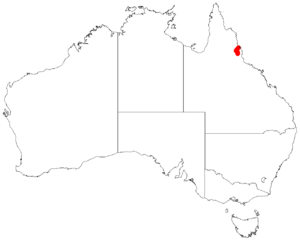Prostanthera clotteniana facts for kids
Quick facts for kids Prostanthera clotteniana |
|
|---|---|
| Conservation status | |
| Scientific classification | |
| Genus: |
Prostanthera
|
| Species: |
clotteniana
|
 |
|
| Where this plant grows in Australia | |
| Synonyms | |
|
|
The Prostanthera clotteniana is a type of flowering plant. It belongs to the Lamiaceae family, which includes mints. This plant is special because it only grows in tropical north Queensland, Australia. When a plant or animal only lives in one specific area, it's called endemic.
This plant is a shrub with branches that are round and hairy. Its leaves are shaped like a narrow egg, wider at one end. The flowers are a pretty purple or light lilac color.
What it Looks Like
The Prostanthera clotteniana is an upright shrub. It usually grows to about 1.5 meters (5 feet) tall. Its stems are covered in tiny hairs.
The leaves are a dull green color. They are narrow and shaped like an egg, with the narrower part closer to the stem. Each leaf is about 19 to 20 millimeters (about 0.75 inches) long. They are also about 3 to 6 millimeters (about 0.1 to 0.2 inches) wide. A small stalk, called a petiole, connects the leaf to the stem.
The flowers grow one by one. They appear where the leaves meet the stem, usually near the ends of the branches. Each flower has small leaf-like parts called bracteoles at its base.
The flower's outer parts, called sepals, form a tube. This tube is about 3 to 4 millimeters long. The petals are purple or light lilac. They are about 15 to 18 millimeters long. The petals are joined together to form a tube, which is about 8 to 12 millimeters long.
How it Got its Name
In 1904, a scientist named Frederick Manson Bailey first described this plant. He called it Hemigenia clotteniana. The next year, in 1905, he described another plant he called Prostanthera atroviolacea. Both plants were found near a town called Herberton.
Later, in 2000, another scientist named Anthony Bean studied these plants. He realized that Hemigenia clotteniana and Prostanthera atroviolacea were actually the same plant. When two different names refer to the same species, they are called synonyms.
So, Anthony Bean gave the plant its current name, Prostanthera clotteniana. He published this new name in a science journal called Austrobaileya. The plant was named after F. E. Clotten. Mr. Clotten helped pay for printing an index for a book about Queensland's plants.
Where it Lives
The Prostanthera clotteniana grows in dry woodlands. It prefers steep, rocky slopes. You can find it in the Ravenshoe and Atherton areas of north-east Queensland.
This plant is very rare. It is only known to exist in seven different places. People thought this plant had completely disappeared until it was found again in 1999.
Protecting This Plant
This plant is in serious trouble. It is listed as "critically endangered" by the Australian Government. This means it is at a very high risk of dying out in the wild. The Queensland Government also protects it.
There are several things that threaten this plant. One big problem is wildfires that happen too often or at the wrong time. Mining activities can also disturb its home. Sometimes, people illegally collect these plants. Weeds, which are plants that grow where they are not wanted, also cause problems for the Prostanthera clotteniana.


